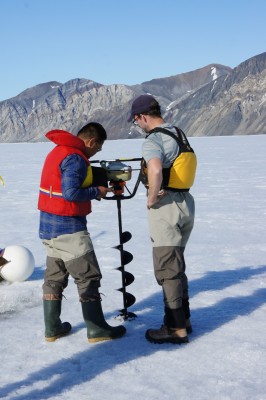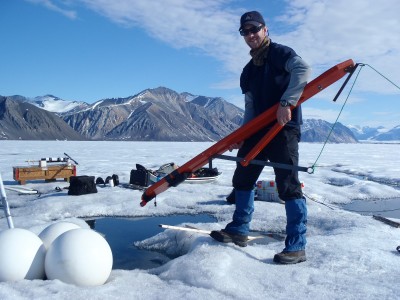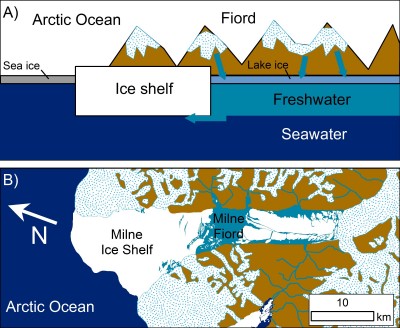Milne Fiord epishelf lake
The last remaining large epishelf lake in the Canadian Arctic is located in Milne Fiord. In 2011, WIRL members (especially Andrew Hamilton) and collaborators began an intensive study to understand the dynamics of the epishelf lake, in particular to investigate the processes that determined changes in the depth of the freshwater layer and how it relates to changes in the thickness of the impounding ice shelf.

Andrew Hamilton and Kevin Xu drill a hole in the Milne Fiord epishelf lake ice to take a water column profile.
We compiled archived Conductivity-Temperature-Depth (CTD) data collected in Milne Fiord since 1983, conducted extensive new CTD profiling between 2009 and present, and analyzed satellite data to monitor the long-term changes in the vertical structure and spatial extent of the lake. We deployed a mooring in May 2011 to continuously record long-term changes in epishelf lake properties, investigate short-term variability (tidal to seasonal timescales) and determine the factors driving changes in the halocline (the steep salinity gradient at the lake-ocean interface).

Andrew Hamilton lowers an ice jigger into the epishelf lake to deploy instruments
So far, we have found that seasonal variations of meltwater inflow and outflow can alter epishelf lake depth by several meters each year and that these seasonal depth changes must be accounted for when considering long-term interannual changes. The depth change was largely due to the outflow of the epishelf lake being constrained to a narrow basal channel in the ice shelf, which limits the rate of drainage, thus prolonging the export of freshwater to the ocean by several months. When the hydraulics and seasonality of the system are accounted for, long-term records of epishelf lake depth show a thinning in the freshwater layer from 18 m in 1983, when it was first profiled, to ~7 m in 2015. However, the change in depth was insignificant for the first part of the record and the system started to change in 2004. From then until 2011 there was a period of steady thinning at 0.50 m a-1 and then a dramatic thinning of almost 5 m from 2011 to 2014. This period of rapid thinning corresponded to a period of warming regional air temperatures, indicating that enhanced melting of the ice shelf, both at the surface and at the base, are leading to loss of the epishelf lake. Continued warming is expected to lead to the breakup of the ice shelf and the imminent loss of the last known epishelf lake in the Arctic.

A schematic of an epishelf lake showing the freshwater layer that is impounded behind the ice shelf. Since the freshwater is less dense than the Arctic Ocean it persists in this layer and forms a lake. A map of Milne Fiord is below.
Resources:
Hamilton, A. K., Laval, B. E., Mueller, D. R., Vincent, W. F., and Copland, L. (2017) Dynamic response of an Arctic epishelf lake to seasonal and long-term forcing: implications for ice shelf thickness, The Cryosphere Discuss., doi:10.5194/tc-2017-19.
Hamilton, A. K. (2016) Ice-ocean interactions in Milne Fiord, Ph.D. Thesis, The University of British Columbia, Vancouver, Canada, http://hdl.handle.net/2429/59051.
Mortimer, C. A., Copland, L., and Mueller, D. R. (2012) Volume and area changes of the Milne Ice Shelf, Ellesmere Island, Nunavut, Canada, since 1950, Journal of Geophysical Research, 117, 1–12, doi:10.1029/2011JF002074, 2012.
Veillette J., Mueller, D.R., Antoniades, D., Vincent, W.F. (2008) Arctic epishelf lakes as sentinel ecosystems: Past, present and future. Journal of Geophysical Research – Biogeosciences 113:G04014. doi: 10.1029/2008JG000730
This research was made possible by in-kind and financial support from Polar Shelf, ArcticNet, NSERC, NSTP and the Canada Foundation for Innovation as well as many field assistants and collaborators.
